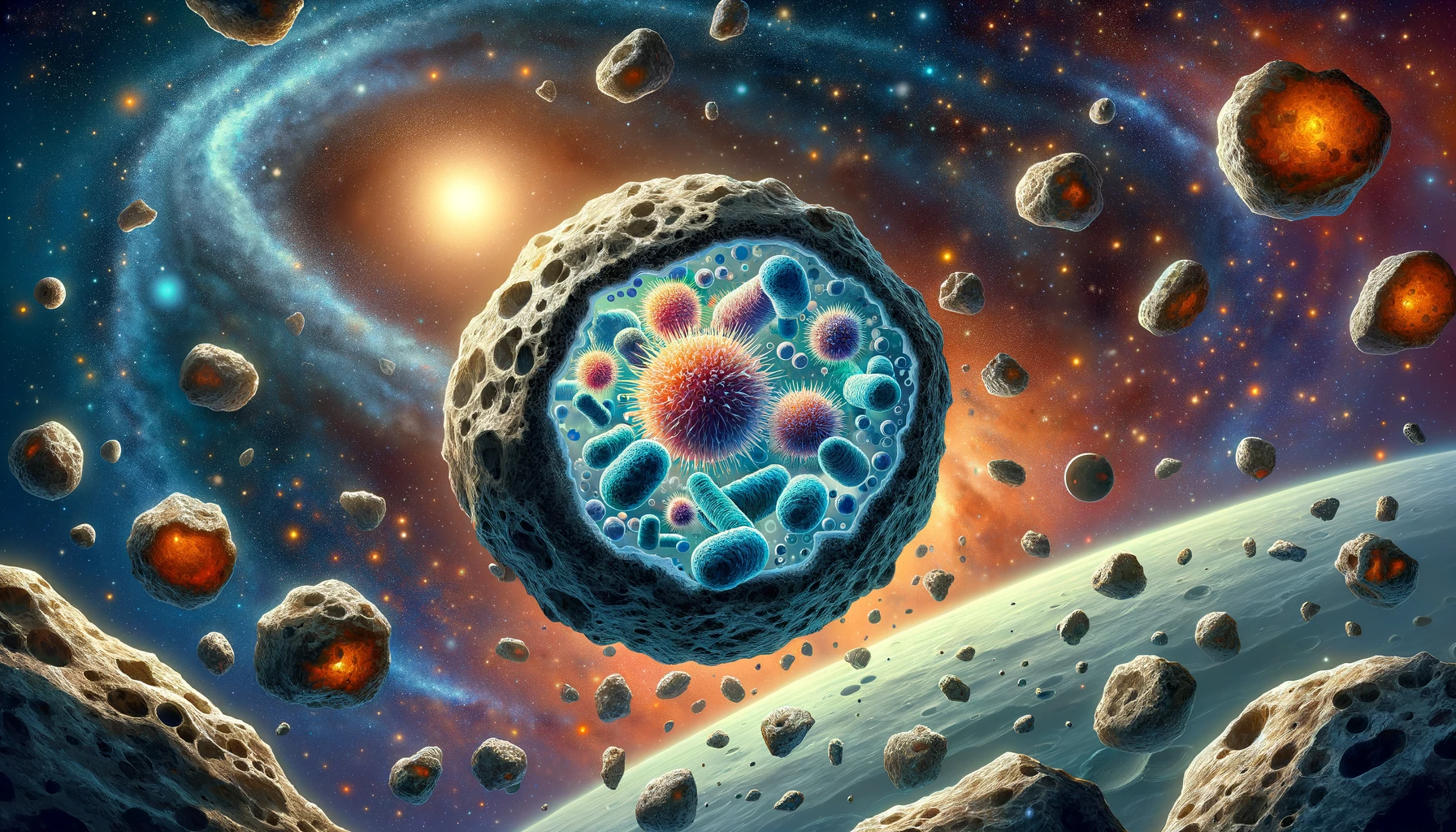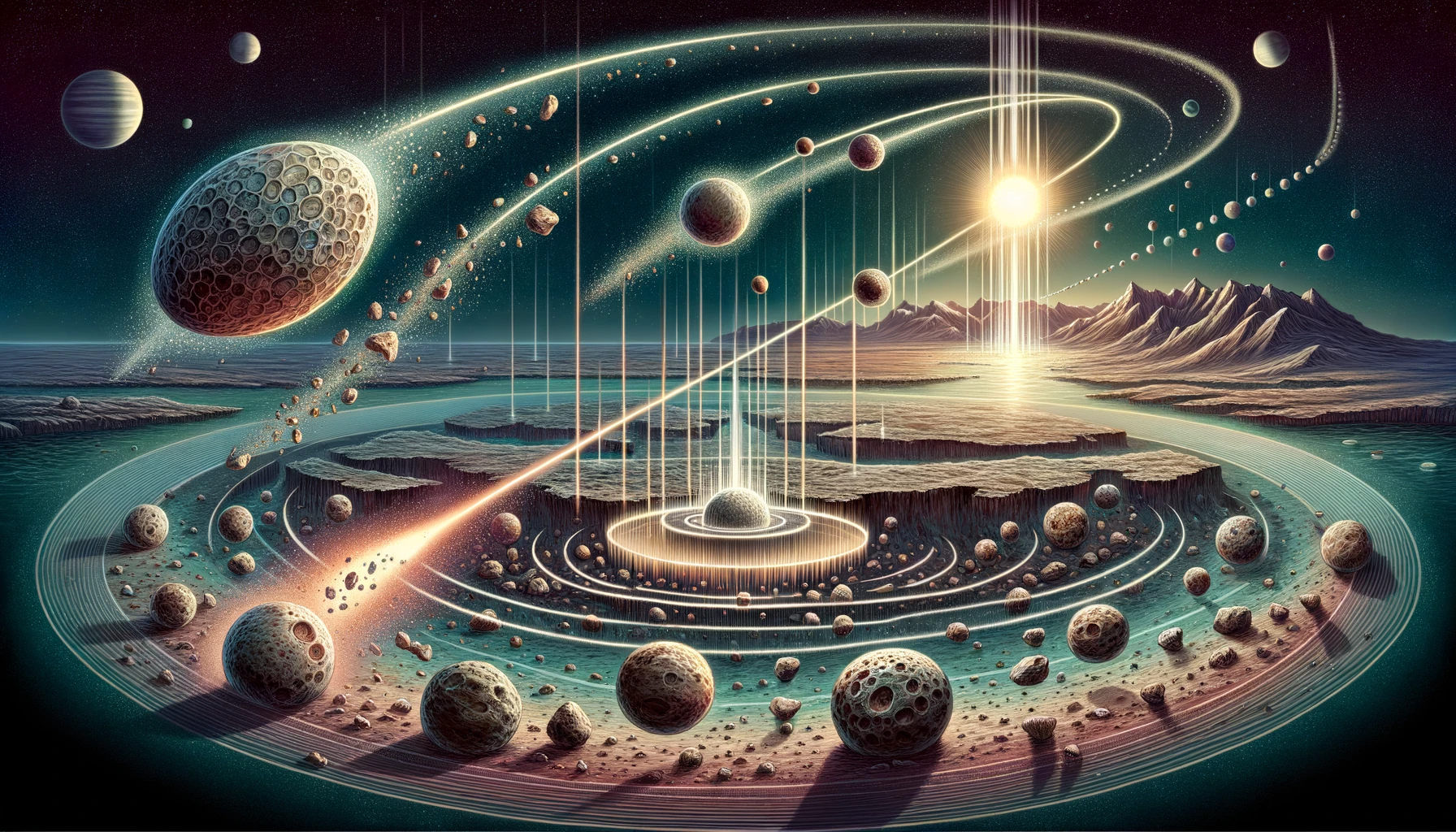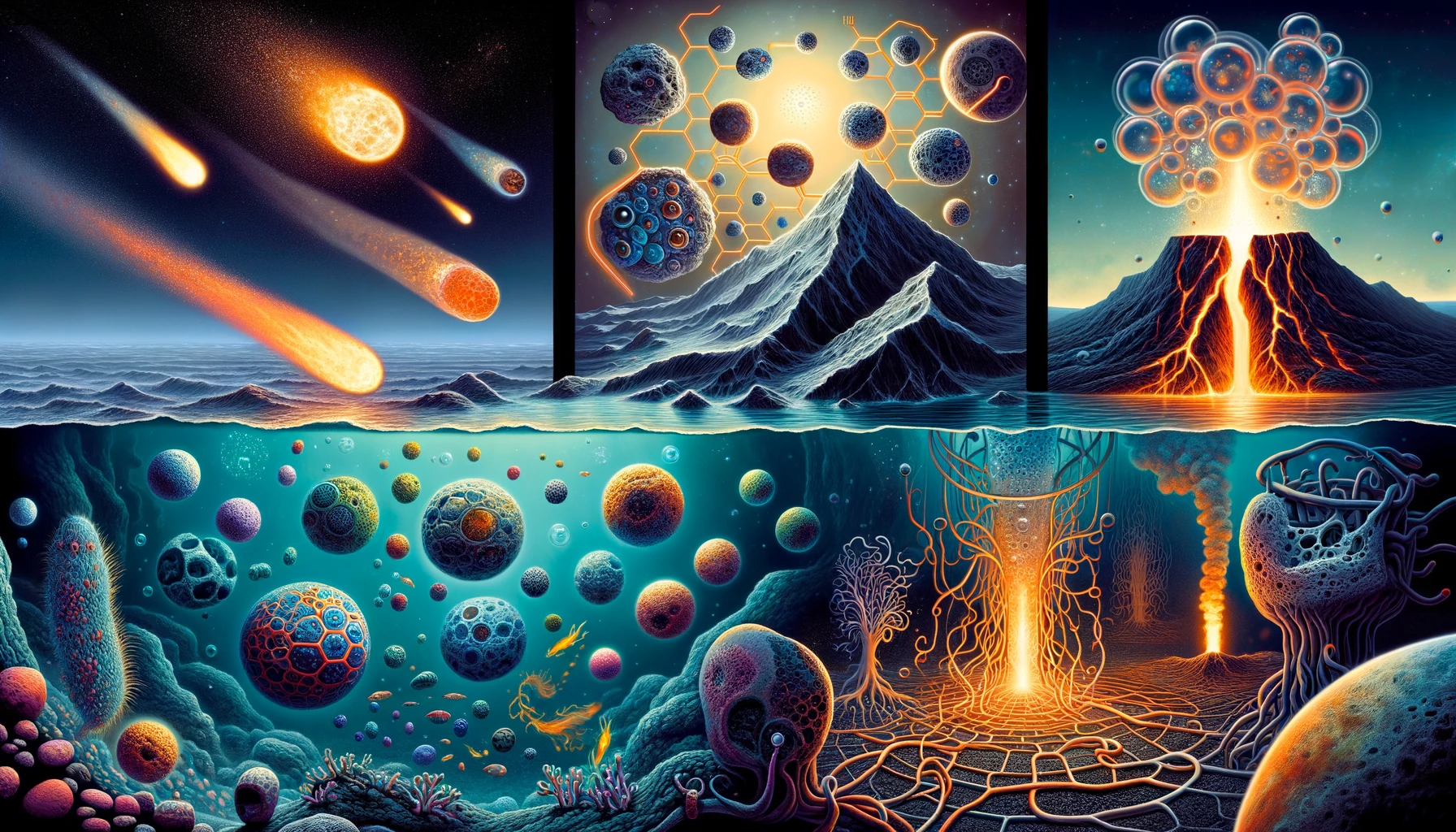Panspermia: The Cosmic Seed of Life
Panspermia presents a captivating hypothesis in astrobiology, proposing that life is a universal phenomenon, potentially seeded throughout the cosmos. Thus making it a core theory of alien life.
This theory suggests that life, particularly in microscopic forms, could be distributed by space dust, meteoroids, asteroids, comets, and even through accidental contamination by spacecraft.
The term itself, derived from Ancient Greek, combines ‘pan’ (all) and ‘sperma’ (seed), encapsulating the idea of life’s omnipresence in the universe.
The Mechanism of Life Distribution
Panspermia doesn’t go into the origins of life but rather explores the mechanisms through which life could spread in the Universe. It suggests that extremophiles, microorganisms capable of surviving harsh space conditions, could hitch rides on debris ejected from planetary collisions.
The Role of Extremophiles
Extremophiles are organisms that thrive in extreme environments, such as high radiation, vacuum, and temperature extremes. These organisms are central to the panspermia hypothesis, as they could endure the journey through space.

Surviving the Vacuum of Space
Extremophiles, particularly those capable of withstanding the vacuum and radiation of space, are prime candidates for panspermia.
Studies have shown that certain microorganisms can survive prolonged exposure to space, raising the possibility that they could travel on comets, asteroids, or even space debris from one planet to another.
Tardigrades: The Poster Children of Panspermia
Tardigrades, also known as water bears, are often highlighted in discussions of panspermia. These microscopic creatures are known for their resilience and ability to survive in extreme environments, including space.
Their endurance suggests that if such organisms can exist on Earth, similar life forms might survive interplanetary journeys.
The Journey Across the Cosmos
The concept of life traveling through space involves several stages:
- Ejection: Life forms, possibly in a dormant state, are ejected from their host planet, likely due to a catastrophic event such as an asteroid impact.
- Survival in Transit: These organisms must survive the harsh conditions of space travel, including cosmic radiation and extreme temperature fluctuations.
- Entry and Adaptation: Upon reaching another celestial body, these life forms must survive the entry process and adapt to a new environment, potentially kick-starting a new ecological system.
Implications for Astrobiology and Space Exploration
The panspermia hypothesis has significant implications for our understanding of life in the universe. It suggests that life might be more common than previously thought and that Earth might not be the only or even the first cradle of life in the solar system.
Space missions to Mars, Europa, and Enceladus, for example, are driven in part by the quest to find evidence of life – or conditions that could support life – beyond Earth. The discovery of extremophiles or their traces on other planets would lend significant support to the panspermia hypothesis.
While panspermia offers an intriguing explanation for the potential spread of life, it faces several challenges. Critics point out that surviving space travel is vastly different from thriving and reproducing in a new environment.
Additionally, panspermia does not address the origin of life itself, merely its distribution. The proof of panspermia might just lead to more questions.
Variants of the Panspermia Hypothesis
Panspermia is not a singular concept but has several variants, each proposing different mechanisms for the spread of life.
Lithopanspermia: Life Riding on Rocks
Lithopanspermia posits a scenario where life, or its precursors, travel across the cosmos aboard rocky materials. This concept is grounded in the idea that meteoroids, asteroids, and cometary bodies, upon colliding with a life-harboring planet, can eject rock fragments into space. These fragments, potentially carrying microbial life, could then journey to other planets.

In lithopanspermia, microorganisms would need to survive the initial impact, the harsh conditions of space, and eventually, the entry into another planet’s atmosphere. This hypothesis gains plausibility from discoveries of meteorites on Earth that originated from Mars, suggesting interplanetary transfer of material is possible. Explore lithopanspermia research
Pseudo-Panspermia: The Organic Molecule Perspective
Also known as molecular panspermia, this variant proposes that organic molecules, the building blocks of life, originated in space and were distributed to planetary surfaces, setting the stage for life to emerge. Understanding molecular panspermia
Historical Perspectives on Panspermia
The concept of panspermia, while enjoying contemporary attention, is actually deeply rooted in historical and philosophical thought, stretching back to ancient times. Its evolution over centuries reflects humanity’s growing understanding of the cosmos and our place within it.
Ancient Origins: Anaxagoras and the Cosmic Sowing of Life
One of the earliest proponents of a panspermia-like idea was the Greek philosopher Anaxagoras, who lived in the 5th century BCE.
Anaxagoras introduced the notion that the essential ingredients of life are present throughout the universe, a concept he referred to as “seeds” of life. This idea was revolutionary, suggesting that life, or the potential for life, was not unique to Earth but was a cosmic phenomenon. Explore Anaxagoras’s contributions

The Evolution of the Idea Through History
Over the centuries, the idea of life existing beyond Earth took various forms in philosophical and scientific thought. In the 19th century, scientists like Lord Kelvin and Hermann von Helmholtz speculated about life’s interplanetary transfer, laying the groundwork for modern panspermia theories. Their ideas, though speculative, began to merge the ancient philosophical concepts with emerging scientific understanding of biology and space.
The Modern Take: Stages of Panspermia
In contemporary science, panspermia is more than just a philosophical idea; it’s a hypothesis with specific stages and mechanisms. Modern panspermia is typically envisioned in three stages:
- Escape: Life, or the building blocks of life, must first escape from its planet of origin. This could occur through natural events like volcanic eruptions or asteroid impacts that eject debris into space.
- Transit: The life forms or organic molecules must then survive the journey through the harsh environment of space, enduring radiation, vacuum, and extreme temperatures.
- Landing: Finally, these materials must land on a new celestial body, survive the impact, and find suitable conditions to either continue existing or to begin the process of life formation.
Panspermia in Contemporary Research
The panspermia hypothesis has not only captivated the imagination of scientists and astrobiologists but has also significantly influenced contemporary space research. This influence is particularly evident in the exploration of Mars and the icy moons of Jupiter and Saturn, where the search for extraterrestrial life forms a core component of various missions.
Mars Exploration: A Key Focus in the Search for Life
Mars, with its past evidence of water and potentially habitable conditions, has become a primary target in the search for life beyond Earth. The panspermia hypothesis suggests that if life ever existed on Mars, it could have been transported to or from Earth or other planets in the solar system. This possibility has driven numerous missions to the Red Planet, aiming to uncover signs of past or present life.
The Role of Rovers and Landers
Rovers like NASA’s Perseverance and earlier missions like Curiosity play a crucial role in this exploration. These missions are designed to analyze Martian soil and atmosphere, searching for organic compounds, microbial life, or fossilized remains of past life. Discover more about Mars missions

The Icy Moons: Europa and Enceladus
Beyond Mars, the icy moons of Jupiter and Saturn, namely Europa and Enceladus, have emerged as exciting candidates for extraterrestrial life search. These moons are believed to harbor subsurface oceans beneath their icy crusts, environments that could be conducive to life.
Europa Clipper and Other Missions
NASA’s upcoming Europa Clipper mission is set to investigate the habitability of Europa’s ocean, looking for signs of life and understanding its potential for supporting life. Similarly, past missions to Saturn’s moon Enceladus have detected water vapor and organic molecules in the plumes erupting from its surface, further fueling interest in these distant worlds. Exploring the potential of Europa and Enceladus
The Search for Extraterrestrial DNA
One of the most groundbreaking aspects of contemporary research influenced by panspermia is the search for extraterrestrial DNA or RNA. Teams from prestigious institutions like MIT and Harvard, supported by NASA funding, are at the forefront of this quest. They aim to develop and deploy instruments capable of detecting molecular evidence of life on other planets, particularly Mars.
The Significance of Molecular Detection
Detecting DNA or RNA on Mars or other celestial bodies would not only support the panspermia hypothesis but also revolutionize our understanding of life in the universe. It would provide concrete evidence that life is not unique to Earth and that the seeds of life can be distributed across the cosmos. MIT and Harvard’s efforts in detecting extraterrestrial DNA
Debating Panspermia: A Fringe Theory?
Its status as a fringe theory or a credible scientific hypothesis is often discussed, reflecting the ongoing challenges in unraveling the mysteries of life’s origins and distribution in the universe.
One of the primary critiques of panspermia is its reliance on a series of highly improbable events – from the survival of life forms in the harsh conditions of space to their successful integration into a new and potentially hostile environment on another planet.
The Challenge of Evidence
A significant hurdle for panspermia is the lack of direct evidence. While the survival of certain extremophiles in space-like conditions has been demonstrated, there is yet no conclusive proof that life has indeed traveled between planets or celestial bodies in this manner. Critical analysis of panspermia evidence
The Origin of Life: Unanswered Questions
One of the most compelling arguments against panspermia as a comprehensive theory is that it merely relocates the question of life’s origin. If life did arrive on Earth from elsewhere in the universe, the fundamental question remains: How and where did life originally begin? Panspermia does not address the mechanisms of life’s genesis but rather its potential spread.
This limitation has led many scientists to view panspermia as part of a larger puzzle rather than a standalone solution to the question of life’s origins. It is often considered alongside other theories, such as abiogenesis, which explores how life could arise from non-living matter on Earth or elsewhere. Comparing panspermia with abiogenesis

The Ongoing Quest in Astrobiology
Panspermia remains a subject of fascination and research in astrobiology, continually pushing the boundaries of our understanding of life in the universe. Its exploration not only challenges existing paradigms but also inspires new lines of inquiry in the quest to understand our cosmic origins.






